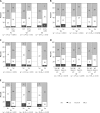Demographic and medical factors affecting short-term changes in subjective evaluation of asthma control in adolescents
- PMID: 30008643
- PMCID: PMC6041703
- DOI: 10.5114/ada.2018.76221
Demographic and medical factors affecting short-term changes in subjective evaluation of asthma control in adolescents
Abstract
Introduction: Asthma control is an important measure of disease stabilization, which is linked to the treatment and lifestyle recommendations.
Aim: To assess the impact of selected factors on asthma control in adolescents, as assessed using the Asthma Control Test (ACT™).
Material and methods: The prospective study included 100 asthma patients aged between 12 and 19. Asthma was assessed in three consecutive follow-up visits spaced 3 months apart, using the standardized ACT™ questionnaire.
Results: Asthma was fully controlled (ACT score = 25 points) in more than half of the patients in all follow-up visits (53.0%, 54.0%, and 56.0%, respectively). More than one third of the participants scored between 20 and 24 points (37.0% vs. 39.0% vs. 40.0%). A minority of patients had uncontrolled asthma (scores below 20), and the group consistently diminished in subsequent visits (10% vs. 7% vs. 4%). Uncontrolled asthma was found significantly more often in female patients (33.33%; p < 0.001) and those living in rural areas (20.59%; p < 0.01). Treatment with a combination of inhaled corticosteroids (ICS) and LABAs was associated with worse asthma control (14.81%; p < 0.05). Better asthma control was found in patients with a family history of allergies (73.85% vs. 75.38% vs. 78.46%; p < 0.001) and in those with concurrent allergies (66.67% vs. 68.00% vs. 70.67%; p < 0.001).
Conclusions: Asthma control in adolescents differs by sex and residence. Concurrent allergies and family history of allergies improve asthma self-control in adolescents.
Keywords: Asthma Control Test; adolescents; asthma; asthma control.
Conflict of interest statement
The authors declare no conflict of interest.
Figures
Similar articles
-
The impact of poor asthma control among asthma patients treated with inhaled corticosteroids plus long-acting β2-agonists in the United Kingdom: a cross-sectional analysis.NPJ Prim Care Respir Med. 2017 Mar 9;27(1):17. doi: 10.1038/s41533-017-0014-1. NPJ Prim Care Respir Med. 2017. PMID: 28270657 Free PMC article.
-
Anticholinergic vs Long-Acting β-Agonist in Combination With Inhaled Corticosteroids in Black Adults With Asthma: The BELT Randomized Clinical Trial.JAMA. 2015 Oct 27;314(16):1720-30. doi: 10.1001/jama.2015.13277. JAMA. 2015. PMID: 26505596 Clinical Trial.
-
[Factors influencing asthma course and the degree of control in the patients assessed with own questionnaire and Asthma Control Test (ACT)].Pneumonol Alergol Pol. 2012;80(3):198-208. Pneumonol Alergol Pol. 2012. PMID: 22562271 Polish.
-
Triple vs Dual Inhaler Therapy and Asthma Outcomes in Moderate to Severe Asthma: A Systematic Review and Meta-analysis.JAMA. 2021 Jun 22;325(24):2466-2479. doi: 10.1001/jama.2021.7872. JAMA. 2021. PMID: 34009257 Free PMC article.
-
Inhaled steroids with and without regular formoterol for asthma: serious adverse events.Cochrane Database Syst Rev. 2019 Sep 25;9(9):CD006924. doi: 10.1002/14651858.CD006924.pub4. Cochrane Database Syst Rev. 2019. PMID: 31553802 Free PMC article.
Cited by
-
Multi-Factor Analysis of Single-Center Asthma Control in Xiamen, China.Front Pediatr. 2019 Dec 3;7:498. doi: 10.3389/fped.2019.00498. eCollection 2019. Front Pediatr. 2019. PMID: 31850293 Free PMC article.
References
-
- Lai CK, Beasley R, Crane J, et al. Global variation in the prevalence and severity of asthma symptoms: phase three of the International Study of Asthma and Allergies in Childhood (ISSAC) Thorax. 2009;64:476–83. - PubMed
-
- Bousquet J, Khaltaev N, Cruz AA, et al. Allergic Rhinitis and Its Impact on Asthma (ARIA 2008) Allergy. 2008;68:8–160. - PubMed
-
- Mallol J, Crane J, Von Mutius E, et al. The International Study of Asthma And Allergies in Childhood (ISAAC) phase three: a global synthesis. Allergol Immunopathol (Madr) 2013;41:73–85. - PubMed
-
- Sembajwe G, Cifuentes M, Tak SW, et al. National income, self-reported wheezing and asthma diagnosis from the World Health Survey. Eur Respir J. 2010;35:279–83. - PubMed
-
- Samoliński B, Raciborski F, Tomaszewska A, et al. Epidemiology of allergic diseases in Poland – ECAP study. Allergy. 2008;63:626–7. - PubMed
LinkOut - more resources
Full Text Sources
Other Literature Sources


